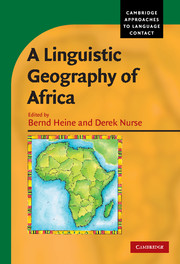Book contents
- Frontmatter
- Contents
- List of maps
- List of figures
- List of tables
- List of contributors
- Series editor's foreword
- Acknowledgments
- Abbreviations
- 1 Introduction
- 2 Is Africa a linguistic area?
- 3 Africa as a phonological area
- 4 Africa as a morphosyntactic area
- 5 The Macro-Sudan belt: towards identifying a linguistic area in northern sub-Saharan Africa
- 6 The Tanzanian Rift Valley area
- 7 Ethiopia
- 8 The marked-nominative languages of eastern Africa
- 9 Africa's verb-final languages
- Notes
- References
- Index
4 - Africa as a morphosyntactic area
Published online by Cambridge University Press: 22 September 2009
- Frontmatter
- Contents
- List of maps
- List of figures
- List of tables
- List of contributors
- Series editor's foreword
- Acknowledgments
- Abbreviations
- 1 Introduction
- 2 Is Africa a linguistic area?
- 3 Africa as a phonological area
- 4 Africa as a morphosyntactic area
- 5 The Macro-Sudan belt: towards identifying a linguistic area in northern sub-Saharan Africa
- 6 The Tanzanian Rift Valley area
- 7 Ethiopia
- 8 The marked-nominative languages of eastern Africa
- 9 Africa's verb-final languages
- Notes
- References
- Index
Summary
Introduction
The aim of the present chapter is to review a list of morphosyntactic features, involving categories and their syntactic functions, which are likely to provide a typological characterization of languages in general. The properties in question are investigated from the following two points of view:
Does the proportion of African languages possessing a given feature (or being devoid of it) seem to be roughly similar to the proportion observed at world level, or to be significantly different?
Are the features whose frequency or rarity characterizes Africa as a whole evenly distributed, or are there geographical clusterings, i.e. areas with a particular concentration of languages possessing or lacking the features in question, and if so, to what degree do such clusterings coincide with or diverge from genetic groupings?
We do not proceed by systematically testing the features we consider on the basis of a language sample pre-established on the basis of statistical methods that would ensure its representativity. Apart from a few reference works whose quality can be taken for granted, this chapter mainly relies on the authors' first-hand knowledge of African data. This undoubtedly limits the bearing of our conclusions (or rather suggestions), but the set of African languages documented in a sufficient way to be systematically used in such a study is so limited that it is simply impossible to extract from it a sample representative of the diversity of African languages.
- Type
- Chapter
- Information
- A Linguistic Geography of Africa , pp. 86 - 150Publisher: Cambridge University PressPrint publication year: 2007
- 83
- Cited by



